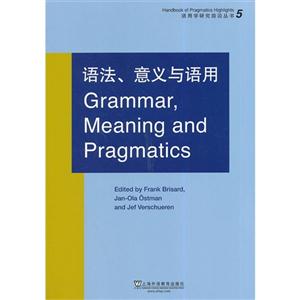扫一扫
关注中图网
官方微博
本类五星书更多>
-
>
心灵元气社
-
>
县中的孩子 中国县域教育生态
-
>
(精)人类的明天(八品)
-
>
厌女(增订本)
-
>
这样学习才高效/杨慧琴
-
>
心理学经典文丛:女性心理学
-
>
中国文化5000年
语法.意义与语用 版权信息
- ISBN:9787544637374
- 条形码:9787544637374 ; 978-7-5446-3737-4
- 装帧:一般胶版纸
- 册数:暂无
- 重量:暂无
- 所属分类:>
语法.意义与语用 本书特色
本丛书为外教社从johnbenjamins出版公司引进的一套10本语言学原版专著,丛书研讨的专题包括了语用学与哲学、认知语言学、语法、社会学、文化学的交叉领域,展现了语用学研究的*前沿发现。布瑞泽所著的《语法意义与语用》为丛书之一。内容包括生成语义学、构式分析、词序、布拉格学派、否定、心理空间、象似性等。
语法.意义与语用 内容简介
“语用学研究前沿丛书”为外教社从John Benjamins出版公司引进的一套10本语言学原版专著,丛书研讨的专题包括了语用学与哲学、认知语言学、语法、社会学、文化学的交叉领域,展现了语用学研究的*前沿发现。
语法.意义与语用 目录
preface to the seriesacknowledgementsintroductionfrank brisard 1. theories of grammar 2. topics in pragmatics 3. naturalizing grammarconstructional analysiskiki nikiforidou 1. construction grammar and pragmatic analysis 2. the pragmatics of grammar 3. extending the scope: conventional pragmatics and conventional discourse 4. constructions in grammaticalization 5. summary and prospectscontrol phenomenabenjamin lyngfelt 1. introduction 2. complement control - object clauses 2.1 control shift 2.2 other kinds of complement control 3. adjunct control 4. arbitrary control 5. less discussed control patterns 5.1 control in noun phrases and adjective phrases 5.2 indirect control 5.3 some other control relations 6. outlookdefinitenessritva laury 1. definite descriptions and reference 2. definiteness and identifiability 3. choice between types of definite expressions 4. definiteness and grammar 5. definiteness marking 6. development of definiteness 7. conclusionemergent grammarmarja-liisa helasvuo 1. introduction 2. routinization and the emergence of grammar 3. emergent grammar within linguisticsframe analysisbranca telles ribeiro & susan m. hoyle 1. introduction 2. what are frames? 3. frame and context in interaction 4. frame and footing 5. framing and nonverbal communication 6. framing in everyday talk 7. framing in play 8. framing and institutional discourse 8.1 framing and education 8.2 framing and medicine 9. perspectives for future researchfunctional discourse grammar: pragmatic aspectsmike hannay & kees hengeveld 1. introduction 2. outline of the model 2.1 fdg and verbal interaction 2.2 the architecture of fdg 2.3 levels and layers 3. the interpersonal level 4. discourse acts and the relations between them 4.1 introduction 4.2 rhetorical functions 4.3 illocution 5. subacts and the relations between them 5.1 introduction 5.2 pragmatic functions 5.3 ascription and reference 6. conclusiongenerative semanticsjames d. mccawley 1. the history of generative semantics 2. tenets of gs 2.1 against deep structure 2.2 derivational constraints 2.3 context and acceptability 2.4 pragmatics integrated in semantics 2.5 the status of logic 2.6 'transformations' 2.7 the 'base' 3. pragmatics in gsiconicityelzbieta tabakowska 1. introduction 2. history 3. iconicity we live by: the state of the art 3.1 iconicity as interpretation 3.2 principles oficonicity 3.3 types of iconicity 3.4 areas of research 4. perspectivesinformation structurejeanette k. gundel & thorstein fretheim 1. introduction 2. what is information structure? 2.1 referential givenness/newness 2.2 relational givenness/newness -- topic-focus structure 3. how do languages express information structure? 3.1 information structure and sentence intonation 3.2 information structure and morphosyntax 4. the grammar-pragmatics interfacemental spacestodd oakley 1. meanings are not "in" the words themselves 2. what are mental spaces? 3. role and value in reference 4. other features of mental spaces theory 4.1 elements, relations, frames 4.2 space builders 5. spaces and the problems of reference, ambiguity, and presupposition 5.1 referential opacity 5.2 pragmatic ambiguity 5.3 presupposition and optimization 6. mental spaces and perspective in conditionals, counterfactuals, and deixis 6.1 conditionals and counterfactuals 6.2 deictic expressions 7. mental spaces and discourse management 8. conclusionmodalityferenc giefer 1. introduction 2. modality in logic 3. necessity and possibility in linguistics 3.1 epistemic modality 3.2 deontic modality 3.3 some further types of modality 3.4 the linguistic tradition 4. evidentials 5. a possible synthesis 6. syntactic treatments of modality 7. modality and pragmatics 7.1 two readings of 'possible' 7.2 the illocutionary meaning of modal verbs 7.3 deontic speech acts 7.4 ability and possibility 7.5 modality and grammaticalization 8. prospectsnegationmatti miestamo 1. scope of negation 2. markedness of negation 3. the expression of negation in the world's languages 4. negative polarity items 5. negation and scalarity 6. metalinguistic negation 7. negative transport 8. negation in diachrony 9. the acquisition of negationprague schoolpetr sgall 1. historical overview 2. main concepts and fields of research 3. prague functionalism and pragmaticsrole and reference grammarrobert d. van valin, jr. 1. introduction 2. historical background 3. central concepts 3.1 clause structure 3.2 semantic structure 3.3 focus structure 3.4 grammatical relations and linking 4. some implications of rrgsemantics vs. pragmaticsken turner 1. fregean beginnings 2. from then until now 3. current manoeuvres: (neo-(post-))gricean pragmatics 3.1 relevance theory 3.2 the least effort hypothesis 3.3 the q-, i- and m-principles hypothesis 3.4 pragmatic intrusion 4. current manoeuvres: (neo-(post-))kaplanean semantics 5. postscript: the logical basis of the semantics-pragmatics interface 6. conclusiontense and aspectrobert l binnick 1. the semantics of markers of tense and/or aspect 1.1 tense 1.2 aspect 1.3 aktionsart 1.4 underspecification and the pragmatics of tense and aspect 2. discourse functions in mta choice 2.1 genre 2.2 focalization 2.3 function 3. discourse coherence in the interpretation of mtas 3.1 discourse coherence 3.2 the linguistic level 3.3 the intentional level 3.4 the attentional levelword ordermiriam fried 1. syntactic typology 2. pragmatic functions of word order 3. cognitive correlates of theme/rheme notions 4. word order in grammatical descriptions and linguistic theory 5. diachronic perspective 6. concluding remarksindex
展开全部
书友推荐
- >
自卑与超越
自卑与超越
¥12.7¥39.8 - >
李白与唐代文化
李白与唐代文化
¥8.9¥29.8 - >
罗庸西南联大授课录
罗庸西南联大授课录
¥13.8¥32.0 - >
二体千字文
二体千字文
¥22.4¥40.0 - >
经典常谈
经典常谈
¥12.7¥39.8 - >
中国历史的瞬间
中国历史的瞬间
¥16.7¥38.0 - >
人文阅读与收藏·良友文学丛书:一天的工作
人文阅读与收藏·良友文学丛书:一天的工作
¥14.7¥45.8 - >
中国人在乌苏里边疆区:历史与人类学概述
中国人在乌苏里边疆区:历史与人类学概述
¥34.1¥48.0
本类畅销
-
字海探源
¥25¥78 -
《标点符号用法》解读
¥8.3¥15 -
文言津逮
¥10.2¥28 -
那时的大学
¥12¥28 -
现代汉语通用字笔顺规范
¥19.6¥58 -
2020年《咬文嚼字》合订本
¥23.8¥60





















